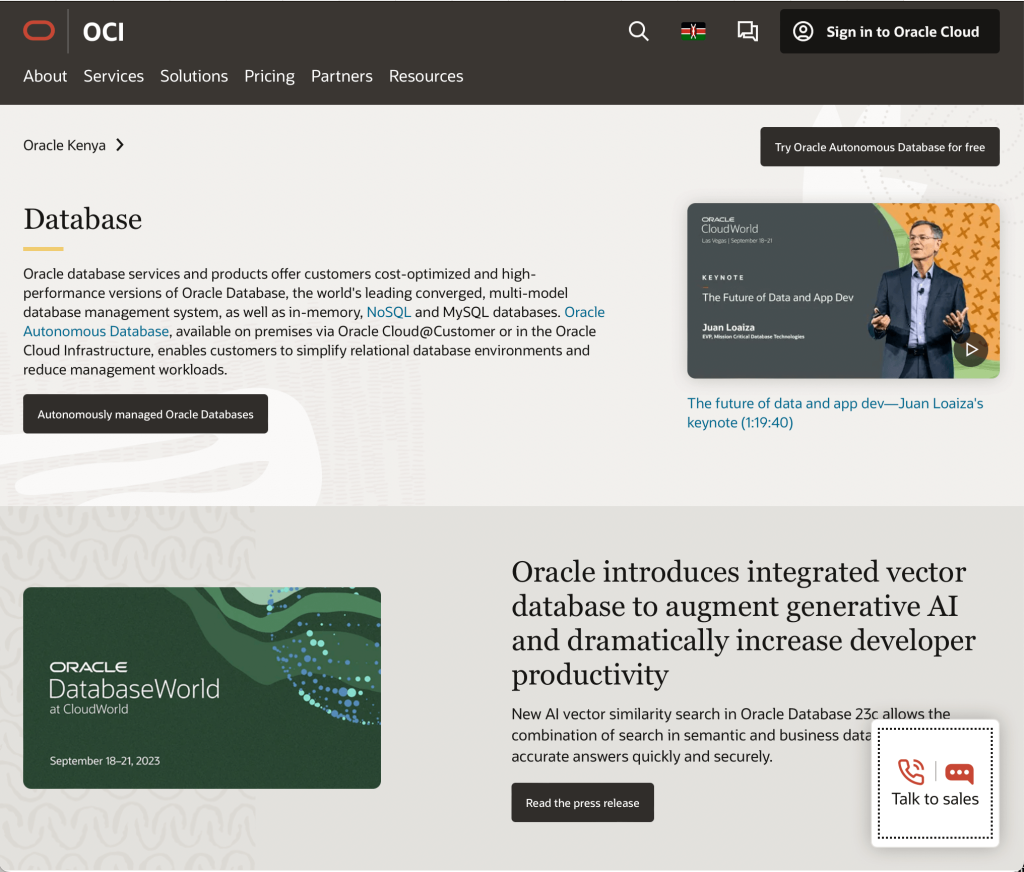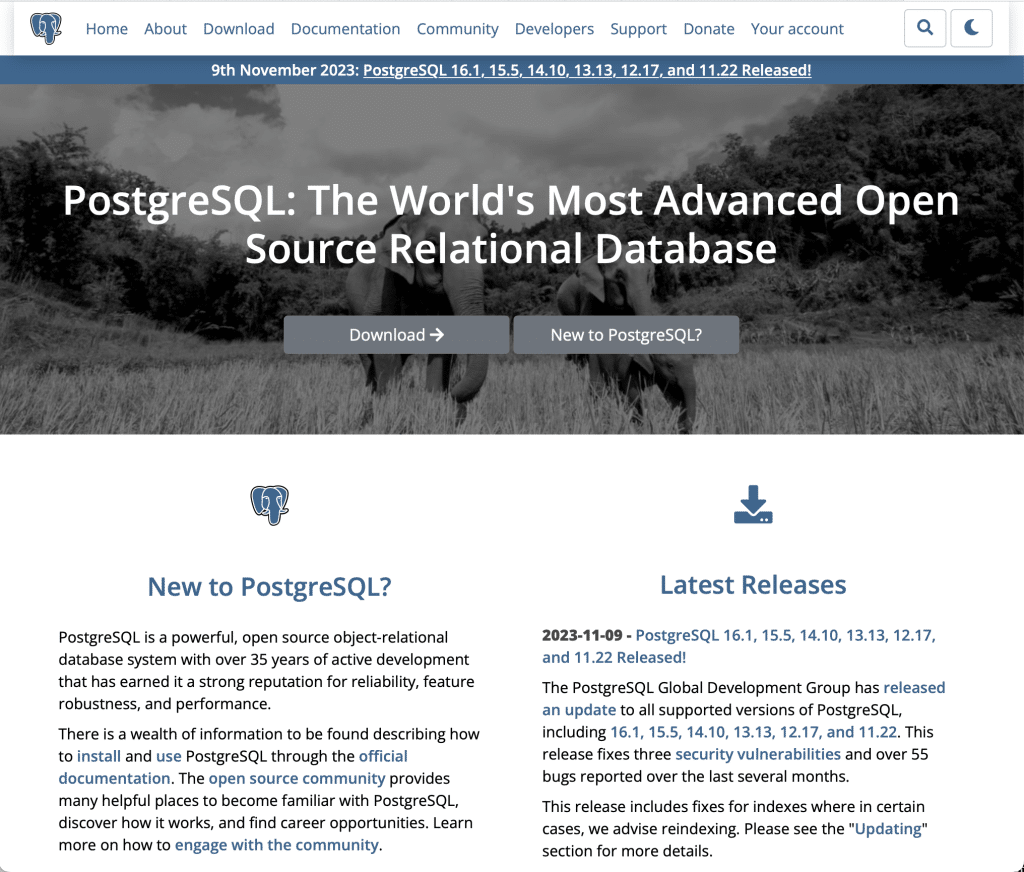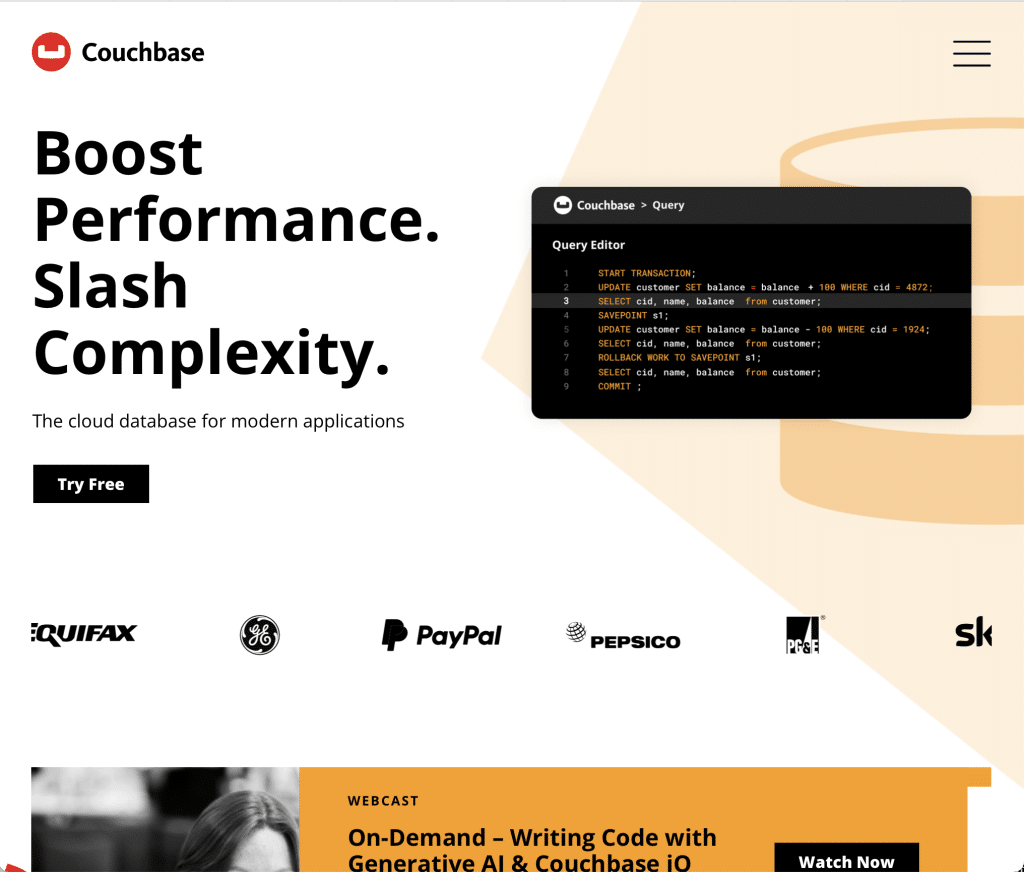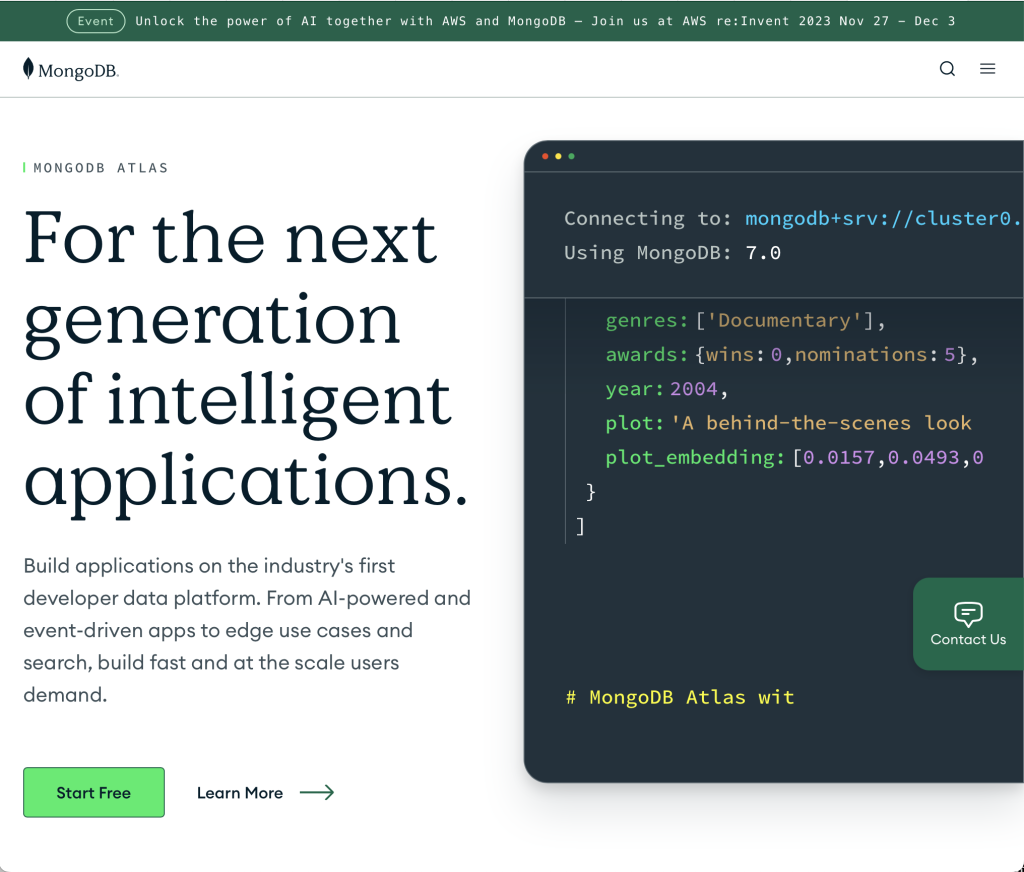Database design is a crucial aspect of any software development process.
Consequently, companies that want to employ professionals with a strong background in designing, maintaining, and optimizing databases include database design questions in their interviews.
Database design interview questions come in different forms and could include:
Database Coding Question (DDL): Create an SQL table for a blog platform with post titles, content, publication dates, and author IDs. Ensure appropriate data types and constraints.
Scenario-Based Question: How would you optimize query performance in a database facing slowdowns during peak usage?
Case Study Question: Redesign a customer database for an e-commerce site with data redundancy issues using normalization techniques. How would you ensure data integrity and reduce duplication?
Basic Definition Question: What’s the role of primary keys in a relational database? Provide examples where primary keys ensure data integrity and table relationships.
In this article, you’ll find various commonly asked database design questions that might be encountered in an interview.
As you review these interview questions and answers, remember that your responses should be clear and concise.
These questions will help you impress in your upcoming database design interview.
So, let’s dive in!

Types of Interview Questions
As we get into specific interview questions, it is prudent for you to understand the types of database design interview questions you can expect:
Type 1: Database Coding Questions
These assess your SQL proficiency, particularly focusing on Data Definition Language (DDL) statements. Expect exercises that test your ability to create, modify, or manage database structures.
Type 2: Scenario-Based Questions
You’ll encounter situations where you’re presented with database issues or challenges. Your task is to articulate your problem-solving process. For instance, you might be asked how you’d handle data errors or performance bottlenecks.

Type 3: Case Study Questions
These questions present a specific problem statement, often related to building a database for a particular feature or scenario on a platform. You’ll need to gather information, analyze requirements, and create an appropriate schema or database architecture.
Type 4: Basic Definitions and Concepts Understanding Questions
These aim to gauge your understanding of fundamental database design concepts. Expect queries related to entity-relationship modeling, normalization forms, indexing, and database architecture principles.
Each category of questions evaluates different aspects of your database design knowledge, problem-solving skills, and practical application abilities.
Now, let’s get into the concepts you need to understand and the questions you might be asked on each.
Database Design Interview Questions

Database design interviews often encompass various topics to assess your expertise in constructing efficient and secure database systems.
We have divided our interview questions into the most relevant topics, namely:
Basic Database Design Concepts
Database Design Stages
Types of Database Management Systems
These topic-based questions will help you evaluate your knowledge, problem-solving skills, and ability to apply database design principles in real-world scenarios.
Topic 1: Basic Database Design Concepts

Understanding the fundamental components of database design is pivotal for excelling in database design interviews. From schema structuring to transaction management and SQL queries, mastering these essential elements forms the core foundation of successful database architecture.
1. SQL and Queries

To excel in database design, you need to be proficient in SQL, the standard language for managing relational databases.
Familiarize yourself with writing and understanding various types of queries and subqueries.
Master the art of SELECT, JOIN, INSERT, UPDATE, and DELETE statements for data manipulation. Additionally, you should be comfortable with using functions and conditional logic in your queries to optimize their performance.
Interview Question Sample 1:
Given a scenario where you have a “Customers” table and an “Orders” table with appropriate relationships, write an SQL query to retrieve the names of customers who have placed more than five orders in the last month.
Interview Question Sample 2:
You’ve inherited a database where certain queries run slowly, affecting the application’s performance. How would you approach optimizing these queries?
Provide an example of a slow-running query and discuss the steps you’d take to improve its performance, considering indexes, query restructuring, or any other optimization techniques you deem relevant.
2. Design Constraints

Design constraints play a crucial role in maintaining the integrity of your database. By understanding and implementing primary keys, foreign keys, and unique constraints, you can prevent duplicate or inaccurate data in your tables.
Examples of constraint implementations include:
Primary key: A unique identifier for each row in a database table. For example, user_id in a users table.
Foreign key: A column in one table referencing the primary key of another table. For instance, a post_author_id column in a posts table referencing the user_id in the users table.
Unique constraint: Ensuring that only unique values are accepted for a given column. It can be applied to an email column to prevent duplicate email addresses.
Interview Question Sample 3:
Imagine you’re tasked with designing a database for a social media platform. How would you implement primary and foreign keys to establish relationships between users, posts, comments, and likes?
Discuss the specific columns where you’d apply these constraints and how they ensure data integrity within the database.
Interview Question Sample 4:
You’re working with a database that has had data integrity issues reported, related explicitly to duplicate entries in a critical table. How would you use unique constraints to prevent duplication and ensure data accuracy?
Provide an example scenario where applying unique constraints would be crucial for maintaining data integrity within the database.
3. Schema and Attributes

A well-designed schema is crucial for effective database design. Your schema should clearly define the entities, attributes, and relationships between them. Entities represent the main objects in your system (e.g., users, products), while attributes describe the properties of these objects (e.g., user_name, product_price).
As you design your schema, focus on normalization techniques to reduce redundant data and enhance data consistency. Also, choose appropriate data types for each attribute to optimize storage and retrieval.
Interview Question Sample 5:
When designing a database schema, explain the significance of choosing appropriate attribute data types. Provide examples of scenarios where selecting specific data types significantly impacts database storage and retrieval efficiency.
Interview Question Sample 6:
You’re tasked with designing a database schema for an e-commerce platform. How would you structure the entities, attributes, and relationships considering normalization techniques to minimize redundancy and enhance data consistency?
Discuss the specific entities and attributes you’d include in your schema and justify your normalization decisions for this scenario.
4. Transactions, Joining, and Ordering

Understanding database transactions is essential for ensuring data consistency and adhering to ACID (Atomicity, Consistency, Isolation, Durability) properties. Learn how to properly start, commit, and rollback transactions to preserve data integrity when dealing with concurrent operations.
When it comes to data retrieval, understanding how to join tables effectively is vital. Familiarize yourself with different types of JOIN operations, such as INNER, OUTER, LEFT, and RIGHT. Moreover, know when to use them to establish data relationships and improve query performance.
Lastly, get acquainted with ordering and sorting techniques. Knowing how to sort your query results significantly boosts data analysis and presentation. Utilize the ORDER BY clause and specify the sorting direction (ASC or DESC) for effective data organization.
Interview Question Sample 7:
Suppose you’re working on a project that requires retrieving data from multiple tables with various relationships. How would you decide which JOIN operation (INNER, OUTER, LEFT, RIGHT) to use in different scenarios?
Additionally, discuss the importance of using the ORDER BY clause to organize query results and its impact on data presentation.
Interview Question Sample 8:
In a multi-user database environment, explain the significance of transaction management in preserving data integrity. Provide an example scenario where multiple users are concurrently updating the same records set and discuss how proper transaction handling can prevent data inconsistencies and maintain ACID properties.
5. Normalization in Database Design

Normalization ensures efficient data organization and integrity by streamlining tables through various stages:
First Normal Form (1NF): Ensures tables contain atomic values, eliminating repeating groups, and ensuring each row has a unique identifier (primary key).
Second Normal Form (2NF): Requires meeting 1NF criteria and ensuring non-prime attributes depend entirely on the primary key, eliminating partial dependencies.
Third Normal Form (3NF): Builds on 2NF by removing transitive dependencies, ensuring non-prime attributes don’t rely on each other via the primary key.
Denormalization: Introduces redundancy intentionally to enhance query performance by reducing joins. Caution is needed as it may impact data consistency and increase storage costs. Always assess benefits against potential drawbacks for specific use cases.
Interview Question Sample 9:
How would you explain the significance of achieving Third Normal Form (3NF) in database design? Provide an example scenario where eliminating transitive dependencies via 3NF would significantly enhance data integrity and query efficiency.
Interview Question Sample 10:
When would you recommend implementing denormalization strategies in a database architecture? Could you outline a scenario where the intentional introduction of redundancy through denormalization dramatically improves query performance without compromising data consistency, and explain your reasoning behind this approach?
6. Security Measures

Security measures in database design encompass an array of strategies aimed at safeguarding data integrity, confidentiality, and accessibility.
Security measures include:
Access Controls: Managing user access through authentication and authorization mechanisms to ensure authorized users interact with designated data, minimizing unauthorized access risks.
Data Encryption: Implementing encryption techniques to protect sensitive information, ensuring data remains confidential and unreadable to unauthorized entities even if breached.
Auditing and Logging: Recording and tracking database activities and access, facilitating monitoring, audit trails, and forensic analysis for identifying potential security breaches or unauthorized actions.
Backup and Recovery Strategies: Implementing strong backup plans includes data replication, and creating duplicate copies of databases across servers or locations. This strategy ensures data availability, fault tolerance, and swift recovery during system failures or security incidents.
Security Patches and Updates: Regularly applying security patches and updates to database management systems and related software to address vulnerabilities and protect against potential threats.
Role-Based Access Controls (RBAC): Assigning access permissions based on user roles or responsibilities, restricting data access to only necessary operations and information for each role.
Interview Question Sample 11:
How would you integrate access controls and encryption techniques within a database system to ensure data confidentiality and minimize the risks of unauthorized access?
Provide examples of access control mechanisms and encryption methods you would employ in different scenarios.
Interview Question Sample 12:
In case of a security breach compromising sensitive data, outline the steps to restore the database system while ensuring minimal data loss and downtime.
Discuss the role of backup and recovery strategies in such scenarios and how they mitigate the impact of security incidents.
By studying these basic concepts and testing your knowledge and skill with these sample questions, you will be one step closer to acing your interview.
Now, let’s look at the database design stages and some interview questions you can expect on the topic.
Topic 2: Database Design Stages

Database design is a crucial aspect of developing and maintaining efficient, reliable, and secure data systems.
As a database designer, you should be familiar with the different stages of database design and be able to answer database design interview questions confidently and effectively.
Here are the stages and some interview question samples for each:
1. Conceptual Data Model
The conceptual data model is the first stage in the database design process. Here, you identify the key entities within the data ecosystem, as well as their relationships and attributes.
This stage focuses on understanding the big picture and laying the foundation for the subsequent stages.
When discussing this in an interview, consider mentioning the following points:
Entity identification: Define the main objects of the system
Relationships: Specify how entities are related to each other
Attributes: Outline the properties of each entity
Interview Question Sample 13:
Can you elaborate on your approach to identifying key entities within a data ecosystem during the conceptual data modeling phase? How do you prioritize and define these main objects in a system?
Interview Question Sample 14:
In conceptual data modeling, specifying relationships between entities is crucial. Could you discuss the significance of defining these relationships and how they contribute to laying a strong foundation for subsequent stages of the database design process?
2. Logical Data Model

Following conceptual models are logical data models, which translate the high-level concepts from the previous stage into a more structured format.
In this stage, you refine the entities, relationships, and attributes and define primary and foreign keys to ensure data integrity.
Your logical design should cover:
Data normalization: Organize the database model to minimize redundancy
Primary and foreign keys: Establish unique identifiers and relationships between entities
Data validation: Incorporate constraints to maintain accuracy
Interview Question Sample 15:
Could you explain the importance of primary and foreign keys in a database and how they contribute to maintaining data integrity?
Interview Question Sample 16:
Imagine you’re tasked with designing a database for an e-commerce platform. Considering primary and foreign keys, how would you structure the logical data model to ensure data integrity?
Additionally, discuss how you would apply data normalization principles to optimize the database schema for this scenario.
3. Physical Database Model

The final stage is the physical data model, where you implement the logical design of the target database management system (DBMS).
This stage involves several steps, such as:
Creating tables: Define the structure of the data storage based on the logical design
Indexes: Utilize suitable indexing strategies to enhance database performance on the database server.
Data storage: Choose suitable file organizations and storage mechanisms
Security: Establish user privileges and access controls for data protection
Interview Question Sample 17:
You’re tasked with implementing a database for a financial institution dealing with sensitive client data.
How would you approach the establishment of user privileges and access controls to ensure robust security measures within the physical database model?
Interview Question Sample 18:
Explain the significance of appropriate indexing strategies in optimizing database performance during the physical database model stage.
How do different indexing techniques contribute to improving query efficiency? Provide an example illustrating the impact of indexing on query performance.
By understanding database design’s different stages and components, you can confidently tackle database design questions in interviews and showcase your skills as a competent database designer.
Now let’s look at some expected database management system interview questions.
Topic 3: Types of Database Management Systems

Understanding the different types of database management systems (DBMS) is essential when preparing for a database design interview.
There are two main categories:
Relational Databases
Non-Relational Databases
Each category has its unique features, advantages, and disadvantages.
1. Relational Databases
Relational databases, also known as SQL databases, are based on the relational model. They organize data into tables with rows and columns, where each row represents an individual record and columns hold attributes or properties of that record.
Some common relational databases include:
Some key concepts to be familiar with when discussing relational databases are:
Normalization: This process aims to eliminate redundancy and improve data consistency. It involves organizing the database into tables structured to minimize data duplication and inconsistencies.
ACID properties: These properties guarantee that database transactions are reliable and consistent. They include Atomicity, Consistency, Isolation, and Durability.
Primary keys: These unique identifiers link records from different tables in a relational database.
Foreign keys: These keys link records from one table to another, establishing relationships between tables.

Interview Question Sample 19:
How do the ACID properties contribute to ensuring data reliability in a relational database management system?
Explain the role of Atomicity, Consistency, Isolation, and Durability in maintaining data integrity across tables during database transactions.
Interview Question Sample 20:
You’ve been tasked with redesigning a database for a retail company that is experiencing data redundancy issues.
How would you approach restructuring the database using normalization techniques to minimize redundancy and ensure data consistency?
Additionally, discuss the importance of primary and foreign keys in maintaining the integrity of this redesigned database.
2. Non-Relational Databases

Non-relational databases, also known as NoSQL databases, do not adhere to the traditional relational model and offer more flexibility and scalability than their relational counterparts.
Some common non-relational databases include:
There are four main types of non-relational databases:
Document-based: These databases store data in documents, typically using JSON or BSON formats. They allow for complex and nested data structures.
Key-value: These databases store data as key-value pairs, making them highly scalable and suitable for applications requiring high-speed access to simple data.
Column-family: These database systems have data stored in columns rather than rows, offering greater performance when dealing with large datasets and write-heavy workloads.
Graph: These databases utilize graph structures to store data, enabling efficient representation of relationships and connections between data entities.

Interview Question Sample 21:
Can you explain the differences between document-based and key-value non-relational databases?
Provide examples of scenarios where each type would be most suitable based on their data storage and retrieval capabilities.
Interview Question Sample 22:
You’re working on a project with data that involves complex relationships between entities. Which type of non-relational database (document-based, key-value, column-family, or graph) would you recommend for efficiently managing and querying this kind of data?
Explain your choice, considering the database’s strengths and how it aligns with the project’s requirements.
Understanding the differences between relational and non-relational databases is essential when discussing database management and design during an interview.
Now, before you walk into your interview, let’s look at some company case studies and some questions you can expect from them.
Company Case Studies
Let’s focus on practical application and scenario-based database design interview questions. By discussing real-world examples and situations, you will better understand how to tackle database challenges at companies like Amazon and Yelp.
Amazon Case Study

A possible scenario for Amazon could be related to managing its considerable product catalog.
An interviewer might ask:
How would you design a database schema to store information about products, their categories, and sellers?
To answer this question, you might suggest creating separate tables for products, categories, and sellers, with appropriate relationships between them. For example:
Products table with columns: ProductID, ProductName, CategoryID, SellerID, Price, Description
Categories table with columns: CategoryID, CategoryName
Sellers table with columns: SellerID, SellerName, SellerAddress
You could then discuss how to establish relationships between these tables (e.g., foreign keys) and potential indexing strategies to optimize query performance.
Yelp Case Study

For the Yelp case study, an interviewer might ask:
How would you design a database schema for storing user reviews, business information, and their respective ratings?
A possible solution could involve three tables:
Users table with columns: UserID, UserName, Email
Businesses table with columns: BusinessID, BusinessName, BusinessAddress, BusinessCategory
Reviews table with columns: ReviewID, UserID, BusinessID, Rating, ReviewText
Again, you could explain the relationships between the tables and how to index the data efficiently for querying purposes.
Mastering Interview Skills for Database Design

Mastering database design interview skills involves honing technical expertise, problem-solving abilities, and effective communication.
Here are some tips for each:
1. Technical Proficiency

Develop a strong foundation in database fundamentals like:
Schema Design: Understand how to structure and organize database schemas efficiently, ensuring optimal data storage and retrieval.
Normalization Techniques: Grasp the concepts of normalization (1NF, 2NF, 3NF) to eliminate redundancies and maintain data integrity.
Query Optimization: Practice constructing complex yet efficient SQL queries, including JOIN operations and aggregation functions, to showcase technical competence.
2. Problem-Solving Approach

Practice solving real-world case studies involving:
Database Redesign: Analyze scenarios requiring database restructuring or optimization to resolve performance issues or enhance data organization.
Performance Optimization: Demonstrate strategies for improving query performance or resolving data integrity concerns through practical problem-solving approaches.
Data Integrity Solutions: Showcase methods to identify and rectify data inconsistencies or redundancy within database systems.
3. Communication and Adaptability
Demonstrate effective communication skills by:
Clear Articulation: Explain intricate database concepts in a straightforward manner, ensuring interviewers comprehend your approach and solutions effectively.
Security Awareness: Discuss access controls, encryption methods, and strategies for maintaining data confidentiality, emphasizing your understanding of database security measures.
Adaptability and Learning: Showcase willingness to learn new technologies, stay updated with industry trends, and adapt to evolving database management methodologies during discussions.
Final Thoughts

In the competitive landscape of database design interviews, a comprehensive understanding of fundamental concepts becomes the cornerstone for success.
Mastery over schema design, normalization, query optimization, and security measures equips you to navigate through diverse challenges.
By delving into the intricacies of database design, you can prepare yourself to answer questions and showcase your ability to architect efficient, secure, and scalable data systems.
With this knowledge, you can step into interviews confidently, ready to demonstrate your prowess in creating robust database architectures that drive innovation and reliability in the digital realm.
If you would like to learn more about data modeling, check out the below video:
Frequently Asked Questions
What are the key principles of normalization in database design?
Normalization is a process to eliminate data redundancy and improve data integrity in databases. There are several forms of normalization, but the most commonly used are:
First Normal Form (1NF): Ensure each column in a table contains atomic values, and there are no repeating groups.
Second Normal Form (2NF): Make sure every non-primary key column is fully dependent on the primary key.
Third Normal Form (3NF): Ensure that non-primary key columns are dependent only on the primary key and not on other non-primary key columns.
How do you design a scalable and maintainable database schema?
To design a scalable and maintainable database schema, follow these steps:
Identify entities and their relationships: Start by determining the main objects and their relationships in the system.
Choose appropriate data types: Select the right data types for each column, considering the range and precision of the data.
Normalize the schema: Apply normalization techniques to reduce data redundancy and improve data integrity.
Use indexing and partitioning wisely: Choose the right indexing and partitioning strategies to optimize query performance.
Plan for growth: Consider the potential for future growth and design the schema to accommodate changes.
What are the differences between a star schema and a snowflake schema?
A star schema is a type of database schema used in data warehousing, where a central fact table is connected to one or more dimension tables using foreign key relationships. It’s called a star schema because the diagram looks like a star with the fact table in the center.
A snowflake schema is an extension of the star schema, where dimension tables are further normalized into multiple related tables. This results in a more complex data structure that resembles a snowflake.
The main differences are:
Star schemas have denormalized dimension tables, whereas snowflake schemas have normalized dimension tables.
Star schemas tend to perform better for querying large datasets, while snowflake schemas may require more joins, which can slow down performance.
Snowflake schemas usually use less storage space, as they eliminate data redundancy.
How do you choose the right indexing strategy for optimizing query performance?
To choose the right indexing strategy for optimizing query performance, consider the following factors:
Frequency of queries: Index columns that are frequently used in WHERE clauses and join conditions.
Uniqueness of data: Indexing columns with a high degree of uniqueness can lead to better query performance.
Update frequency: Avoid indexing columns that are frequently updated, as index maintenance can slow down update performance.
Read vs. write performance: Consider the trade-offs between read and write performance. Indexing improves read performance but can slow down writes.
Index types: Choose the appropriate index type (e.g., B-tree, bitmap, or hash) based on the nature of the data and query patterns.
What are the primary considerations when partitioning a table?
When partitioning a table, consider the following factors:
Partition key: Choose a column that distributes the data evenly across partitions to avoid skew.
Access patterns: Partition the table based on how the data is queried, allowing for efficient access to required data.
Manageability: Ensure partitioning results in manageable chunks of data to facilitate backup, maintenance, and other administrative tasks.
Space and performance: Evaluate the performance benefits and space requirements when choosing the partitioning method.
What is the role of entity-relationship diagrams in database design?
Entity-relationship diagrams (ERDs) are visual representations of the entities, attributes, and relationships in a database schema. They play an essential role in database design by:
Identifying and defining entities: ERDs help to identify entities and their attributes in the system, assisting in the creation of database tables.
Visualizing relationships: ERDs depict the relationships between entities, showing cardinality and participation constraints.
Facilitating communication: ERDs provide a common language for developers, stakeholders, and other team members to discuss and understand the database schema.
Validating the design: ERDs help validate the design by identifying potential issues, redundancies, or missing relationships before implementation.








